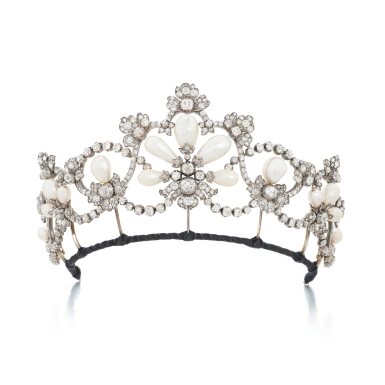Vienna 1900: An Imperial and Royal Collection
Vienna 1900: An Imperial and Royal Collection

From the Collection of Princess Maria Immaculata of Bourbon-Two Sicilies, Archduchess of Austria-Tuscany (1844-1899)
Köchert
Historical and important natural pearl and diamond tiara
Auction Closed
November 7, 12:14 PM GMT
Estimate
270,000 - 450,000 CHF
Lot Details
Description
From the Collection of Princess Maria Immaculata of Bourbon-Two Sicilies, Archduchess of Austria-Tuscany (1844-1899)
Historical and important natural pearl and diamond tiara, Köchert, late 19th century
Of openwork, garland design, set with drop- to slightly baroque drop-shaped natural pearls measuring approximately from 10.50 - 12.65 x 18.60mm to 7.70 - 7.75 x 9.70mm, set throughout with cushion-shaped and circular-cut diamonds, inner circumference approximately 240mm, unsigned, maker's marks for Köchert, Austrian assay marks for gold, screwdriver, brooch and comb fittings for the central element, two hairpin fittings, five central elements detachable, thirteen pearl pendants detachable, fitted case stamped Köchert.
Accompanied by SSEF report no. 131220, stating that the pearls were found to be natural, saltwater; together with an appendix letter.
Archduchess Maria Immaculata of Austria-Tuscany, Duchess of Württemberg (1878-1968)
Archduchess Maria Immaculata of Austria-Tuscany, Duchess of Württemberg (1878-1968) described this natural pearl and diamond tiara as having belonged to her mother Princess Maria Immaculata of Bourbon-Two Sicilies, Archduchess of Austria-Tuscany (1844-1899).
Viennese jewellers
The great representative parures produced for the court, though highly impressive, were first and foremost dignified, classical creations meant to be worn for decades and withstand ever changing fashions. To achieve this timeless quality, large pieces were usually transformable in a multitude of clever ways. Tiaras could be worn as necklaces, necklaces could come apart as bracelets, pendants could be removed or added at will and individual elements could be unscrewed for alternative wear as brooches and hairpins.
All through the nineteenth century, jewellery followed wider artistic currents. In the romantic era of the 1830 and 1840s, Viennese jewellery was renowned across Europe for its mastery of light, naturalistic sprays of floral and foliate design. Over the following decades Köchert and other Viennese jewellers would often return to this theme with great success. During the mid-19th century, high jewellery explored historicizing themes following medieval and renaissance examples. At the Vienna World Fair of 1873, Köchert for instance presented a tiara of Byzantine style and a Swan parure influenced by the pseudo-medieval themes Richard Wagner’s operas.
However, it would be the neo-rococo style that would have the most lasting influence. The flowing ribbons and bows, openwork rinceaux and charming asymmetrical compositions of 18th century decorative arts translated particularly well into jewellery. Köchert created countless variations on this theme often combined with floral elements. By the early 1900s, the scrolling lines of art nouveau could be discerned in high jewellery, but always interpreted in a discreet way blending in seamlessly with more traditional decorative elements. Under the influence of Parisian jewellers, Viennese jewels of the 1910s took on light, delicate, Louis XVI-inspired designs in platinum settings, ever so slightly foreshadowing the geometric styles that would become predominant after World War I.
Today, the firm of A.E. Köchert is perhaps the only widely remembered Viennese jeweller. Köchert’s wonderfully preserved archive gives a rare glimpse into 19th century Viennese jewellery production. Von Mack was court jeweller for some 40 years in the Biedermeier era. When he passed away, Köchert and Biedermann were jointly appointed court jeweller by a young Emperor Franz Joseph. In the mid-19th century, Biedermann was Köchert’s main competitor who also received important Imperial commissions. V. Mayer, Schwarz & Söhne was a highly regarded company that also held the title of court supplier. This jeweller mainly specialized in orders and insignia of which the court was always ordering large quantities. The high nobility also frequented the fashionable jewellers Moritz Hübner and Wilhelm Haarstrick in the late 19th and early 20th century.
The end of the Habsburg monarchy deprived these jewellers of their raison d’être. Without court life, the magnificent parures and bejewelled decorations of yesteryear had become obsolete. With the exception of Köchert, almost none of the main fin de siècle Viennese jewellery houses survive today. This unique Imperial and Royal collection having remained virtually undivided and unaltered since the early twentieth century, provides a unique chance to study Viennese jewellery of the belle époque and rediscover the talent of these forgotten masters.
